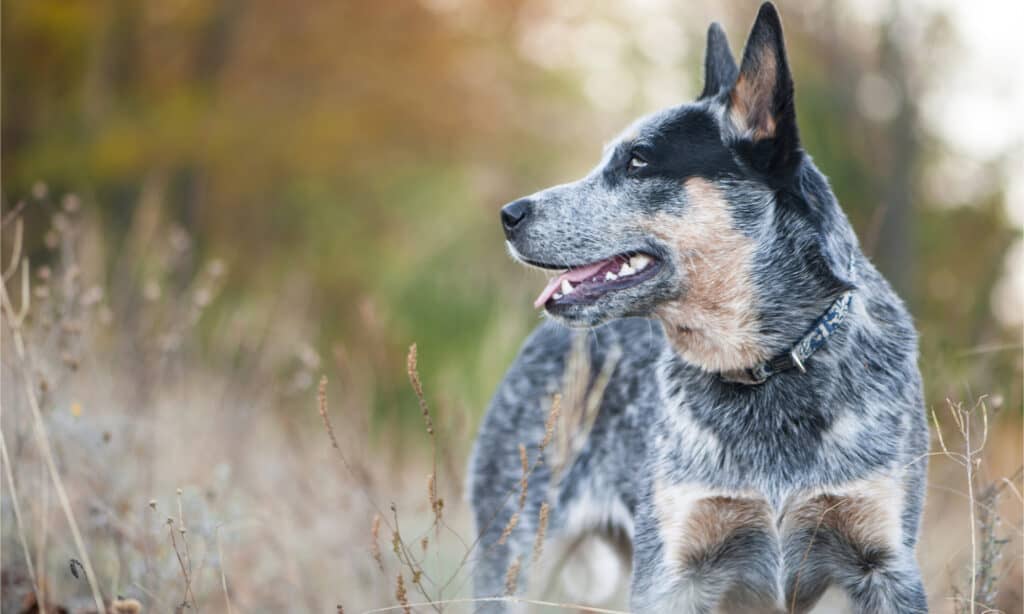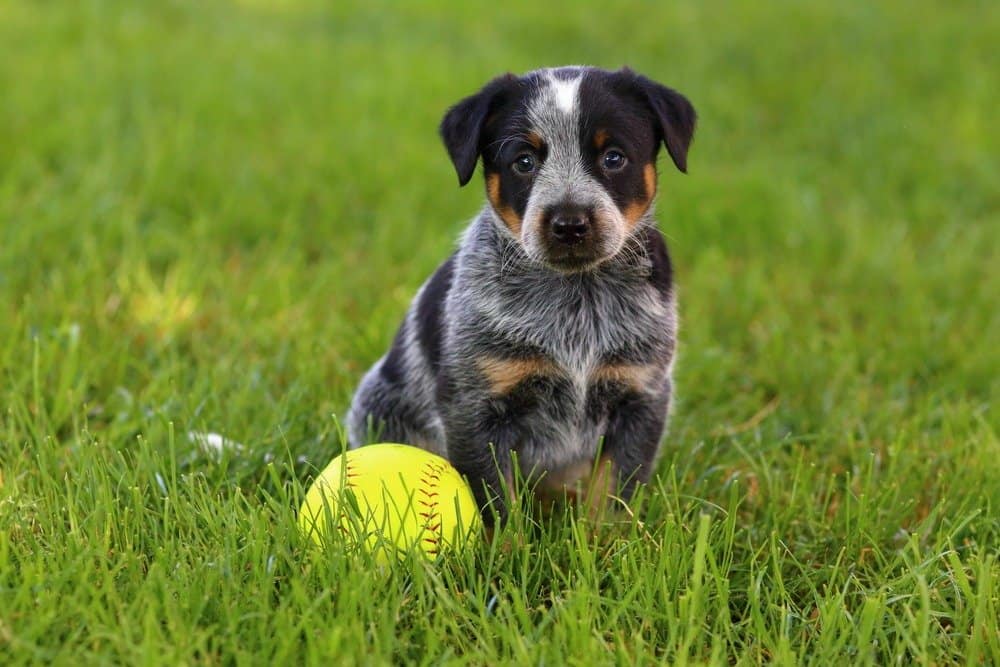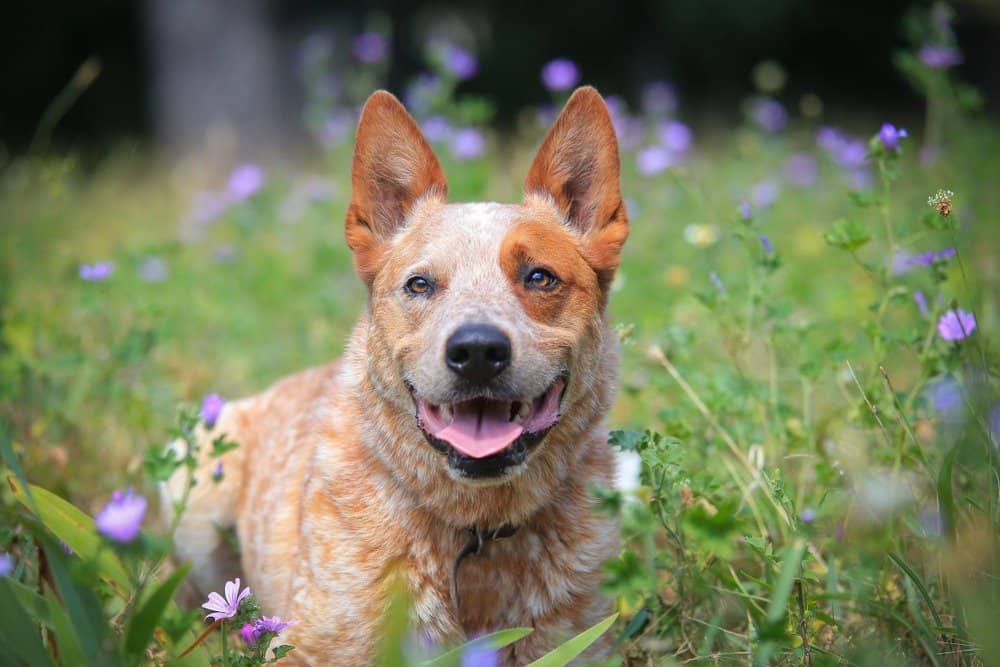When it comes to the Mini Blue Heeler vs the Standard Heeler, there are a few key differences: size, breeding restrictions, and American Kennel Club (AKC) recognition.
The Standard Heeler, also known as the Australian Cattle Dog, is recognized by the AKC and thus has restrictions and a breed standard. Minis don’t have these restrictions, though breeders may choose to abide by them when it comes to the coat and markings.
Standard Heelers are also, of course, larger than Mini Blue Heelers!
Keep reading to learn more about the Australian Cattle Dog and its mini-me, the Mini Blue Heeler.
Comparing Mini Blue Heeler Vs Standard Heeler

| Mini Blue Heeler | Standard Heeler | |
|---|---|---|
| Size | 11-15 inches, 12-25 pounds | 17-20 inches, 35-50 pounds |
| Appearance | Blue or red coat with unregulated markings (typically the same as the standard breed) | Blue or red coat with specific markings allowed according to AKC breed standards |
| Lifespan | 12-16 years | 12-16 years |
| Temperament | Protective, energetic, and intelligent | Protective, energetic, and intelligent |
| Energy Level | High | High |
| Training | Easy | Easy |
| Grooming | Weekly | Weekly |
| AKC Recognition | Not recognized | Recognized (Australian Cattle Dog) |
Key Differences Between Mini Blue Heeler And Standard Heeler
The key difference between the Mini Blue Heeler and Standard Heeler is its size. Another notable difference is AKC recognition.
Otherwise, these breeds are remarkably similar. After all, the point of breeding Mini Heelers is to replicate the original in a smaller form!
Let’s dive into these differences and learn more about these dogs below.

Mini Blue Heelers are five inches shorter than Standard Heelers on average.
©LNbjors/Shutterstock.com
Mini Blue Heeler Vs Standard Heeler: Size
This is the only physical difference between these dogs, unsurprisingly. While we’ll get into more potential differences below, the main goal in breeding Mini Heelers is to uphold the same traits as their Standard counterparts.
Mini Blue Heelers stand at 11-15 inches and weigh only 12-25 pounds. Standard Heelers are about double the size at 17-20 inches and 35-50 pounds.
When considering what size of dog to adopt, consider expenses and guarding ability. Mini Heelers aren’t very imposing, though they will have that guarding instinct still intact!
Of course, Standard Heelers will cost more to feed and vet. Items like collars, food bowls, and beds will also be more expensive due to their larger size.
Standard Heelers may be more difficult to control on a leash or to lift when needed.

Autumn beauty portrait of Australian cattle dog
© Iryna Dobrovynska/Shutterstock.com
Mini Blue Heeler Vs Standard Heeler: Appearance
According to the AKC breed standard, the Standard Heeler can have the following coat colors:
- Blue
- Blue mottled
- Blue speckled
- Red speckled
- Red mottled
They can also have tan, black and tan, or red markings.
These pups also have cute triangular ears that stand upright naturally as they grow. Their legs are short for their size, and they’re short-haired with fluffy tails.
Mini Blue Heelers look exactly the same, only smaller. However, breeders don’t have to abide by breed standards for Minis. Therefore, you might see coat patterns or markings that aren’t typically seen in the standard breed.
Despite their name, Mini Blue Heelers can be red or blue in color. The Standard Heeler is also sometimes called a Blue Heeler, and this can refer to either the color of the dog or the breed as a whole!
Mini Blue Heeler Vs Standard Heeler: Lifespan
Australian Cattle Dogs live to be a whopping 12-16 years old. Even more impressive? The oldest dog ever recorded was a Standard Heeler named Bluey who lived to be 29 years and 5 months old!
Generally, small breeds live longer than large ones. It would make sense that Mini Heelers live longer than their standard counterparts, but we don’t yet have evidence of this.

Cute Texas Blue Heeler puppy running in the park at sunset.
©Chris Curtis/Shutterstock.com
Mini Blue Heeler Vs Standard Heeler: Temperament
Standard or Mini, you’re going to get an excellent dog with a great temperament when you adopt a Heeler!
These dogs are incredibly intelligent and are said to outsmart their humans regularly! They’re also incredibly active, playful, and tons of fun.
They can be quite protective of their family and territory, which comes with its pros and cons. You will want to socialize these pups so they learn not to fear strangers, and so that they don’t think aggression toward strangers or guests is okay.

Australian Cattle Dog (red male)
©Ellen Levy Finch (Elf) / CC BY-SA 3.0, from Wikimedia Commons, the free media repository – License
Mini Blue Heeler Vs Standard Heeler: Energy
When it comes to energy, heelers are full of it! A daily walk won’t be enough for these energetic pups. Instead, they require a daily run accompanied by other enriching activities.
Every smart dog needs their brain challenged daily. Puzzle toys, games, training, and other forms of enrichment are a must.
You’re likely to see behavioral problems if you don’t engage your dog’s body and mind extensively. Your dog will also be unhappy and run the risk of health problems if they get too little exercise.
Mini Blue Heelers will likely be easier to tire out than standard Australian Cattle Dogs, only because of their size. This makes it easier to exercise them indoors with games of fetch, rather than needing a large outdoor space.
Standard Heelers do best with an enclosed backyard to run around in, but be sure to engage them! They’re unlikely to get out all of that energy on their own and will become bored.

Both Standard and Mini Blue Heelers have a lot of energy! They do best with an enclosed backyard and lots of human interaction.
©JLSnader/Shutterstock.com
Mini Blue Heeler Vs Standard Heeler: Training
When it comes to training, these dogs are eager to please and very smart! They’ll catch onto new tricks quickly.
However, there are a few challenges to keep in mind:
- They’re super smart! This means they’re more likely to become bored or have their own ideas of what they should do. Keep training sessions short and exciting to prevent this.
- Heelers are herding dogs. They herd animals by nipping their heels—and they might decide your family, kids, or other pets are theirs to herd! Combat this by disengaging and walking away. Separate them from kids or animals if necessary, but don’t punish this instinctive behavior. They’re more likely to learn the right way to interact if given a firm boundary—and rewards when they interact nicely!
- They have guarding instincts. Socialize them well as puppies so that they don’t become wary of strangers or guests.
- Their prey drive is strong. This means they have a tendency to run after perceived prey. When they’re focused on the hunt, they’re unlikely to respond to recall. Keep them on a leash or enclosed at all times!
Mini Blue Heeler Vs Standard Heeler: Grooming
Grooming for both breeds is easy, though it’ll take less time with a Mini Blue Heeler. They’ll also shed proportionately less.
Heelers shed moderately and should be brushed quickly just once a week. During their shedding season in the spring and autumn, brush them more thoroughly every few days. A comb might help to completely gather the shed undercoat.

The Australian Cattle Dog (Standard Heeler) is recognized by the AKC, while the Mini Heeler isn’t.
©Melounix/Shutterstock.com
Mini Blue Heeler Vs Standard Heeler: AKC Recognition
The Standard Heeler is recognized by the AKC, though not by this name. You can find them listed as Australian Cattle Dogs.
Mini Blue Heelers aren’t recognized by the AKC, and thus don’t have a breed standard. That said, breeders are likely to stick to the Australian Cattle Dog standards when it comes to everything but size.
Do Blue Heelers Have Dingo in Them?
Heelers were selectively bred by incorporating traits from Dalmatians, Collies, and Kelpies. Back in 1840, Thomas Simpson Hall, an early colonist and cattle farmer, carried out a crossbreeding program by mixing dogs that had been bred from various collie lineages and a dingo.
The puppies excelled as dependable working dogs, and their reputation quickly spread, resulting in nearby cattle farmers eagerly acquiring their litters.
Further, dingoes share a close genetic kinship with the New Guinea singing dog. Their lineage diverged at an early stage from the one that ultimately led to modern domestic dogs, and it can be traced back through Maritime Southeast Asia to Asia.
Are Mini Blue Heelers Mixed Breeds?
Mini Blue Heelers can be bred in one of several ways. One of these is to mix a Blue Heeler and a smaller breed dog.
These puppies would be a mixed breed and their appearance would be inconsistent, with some looking like either parent and some being a mixture.
There isn’t a way to ensure, using this method, that the pups all look like mini Heelers.
The second way is to breed small standard heelers together for generations until finally, the puppies are miniature! These dogs would technically be purebred, but wouldn’t meet the AKC breed standard.
Lastly is an unethical way of breeding—a breeder could introduce the dwarfism gene into their line, making the puppies smaller. This would also introduce health problems and we recommend avoiding these breeders at all costs!
The photo featured at the top of this post is © Iryna Dobrovynska/Shutterstock.com
Ready to discover the top 10 cutest dog breeds in the entire world?
How about the fastest dogs, the largest dogs and those that are -- quite frankly -- just the kindest dogs on the planet? Each day, AZ Animals sends out lists just like this to our thousands of email subscribers. And the best part? It's FREE. Join today by entering your email below.
Thank you for reading! Have some feedback for us? Contact the AZ Animals editorial team.






